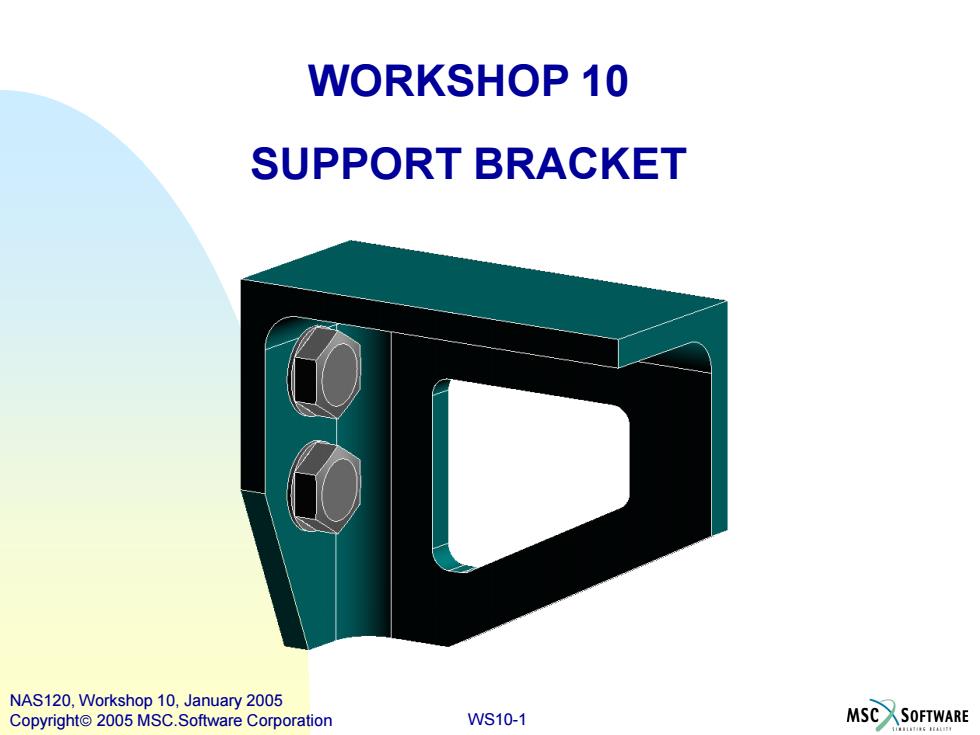
WORKSHOP 10 SUPPORT BRACKET NAS120,Workshop 10,January 2005 Copyright 2005 MSC.Software Corporation WS10-1 MSC SOFTWARE
WS10-1 WORKSHOP 10 SUPPORT BRACKET NAS120, Workshop 10, January 2005 Copyright 2005 MSC.Software Corporation
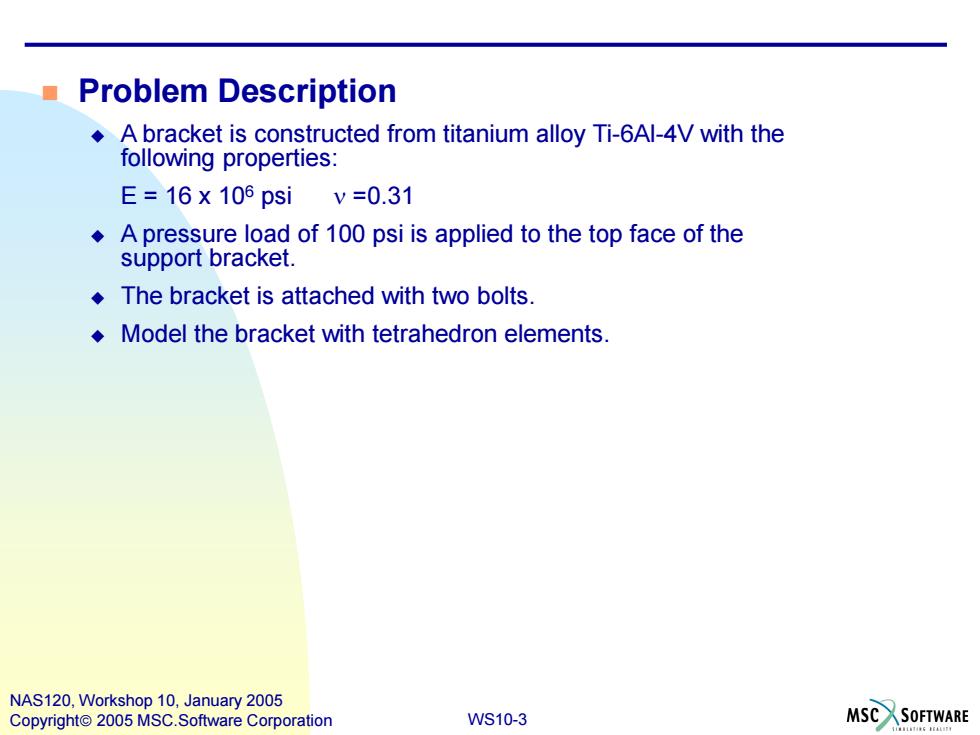
■Problem Description A bracket is constructed from titanium alloy Ti-6Al-4V with the following properties: E=16x106psiv=0.31 A pressure load of 100 psi is applied to the top face of the support bracket. The bracket is attached with two bolts Model the bracket with tetrahedron elements NAS120,Workshop 10,January 2005 Copyright 2005 MSC.Software Corporation WS10-3 MSCSOFTWARE
WS10-3 NAS120, Workshop 10, January 2005 Copyright 2005 MSC.Software Corporation Problem Description A bracket is constructed from titanium alloy Ti-6Al-4V with the following properties: E = 16 x 106 psi n =0.31 A pressure load of 100 psi is applied to the top face of the support bracket. The bracket is attached with two bolts. Model the bracket with tetrahedron elements
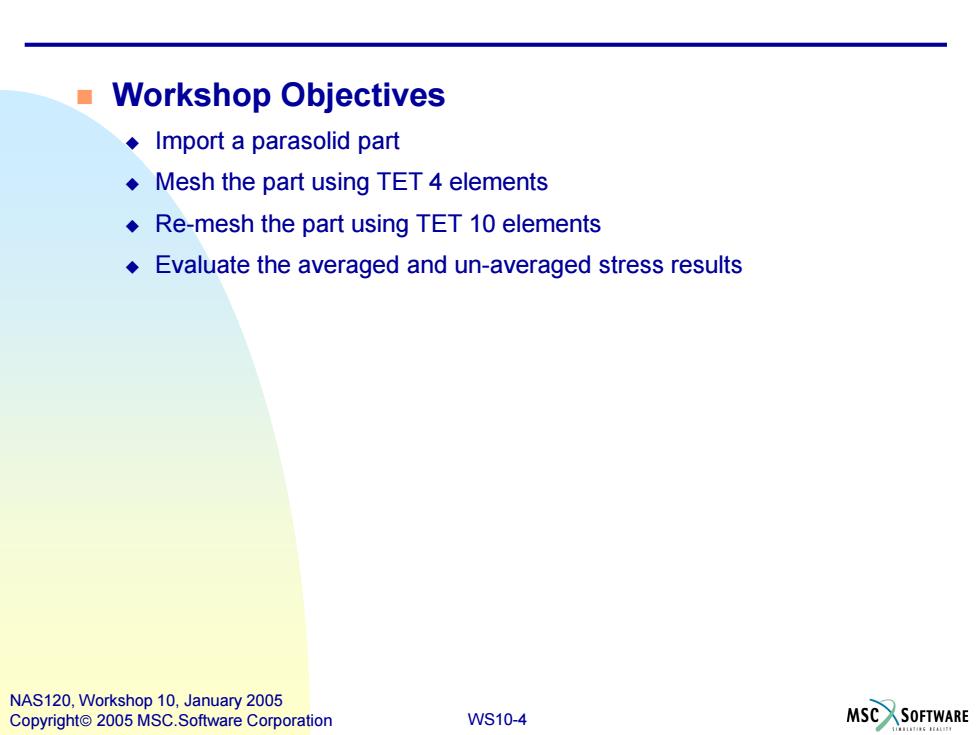
■ Workshop Objectives Import a parasolid part Mesh the part using TET 4 elements Re-mesh the part using TET 10 elements Evaluate the averaged and un-averaged stress results NAS120,Workshop 10,January 2005 Copyright 2005 MSC.Software Corporation WS10-4 MSC SOFTWARE
WS10-4 NAS120, Workshop 10, January 2005 Copyright 2005 MSC.Software Corporation Workshop Objectives Import a parasolid part Mesh the part using TET 4 elements Re-mesh the part using TET 10 elements Evaluate the averaged and un-averaged stress results
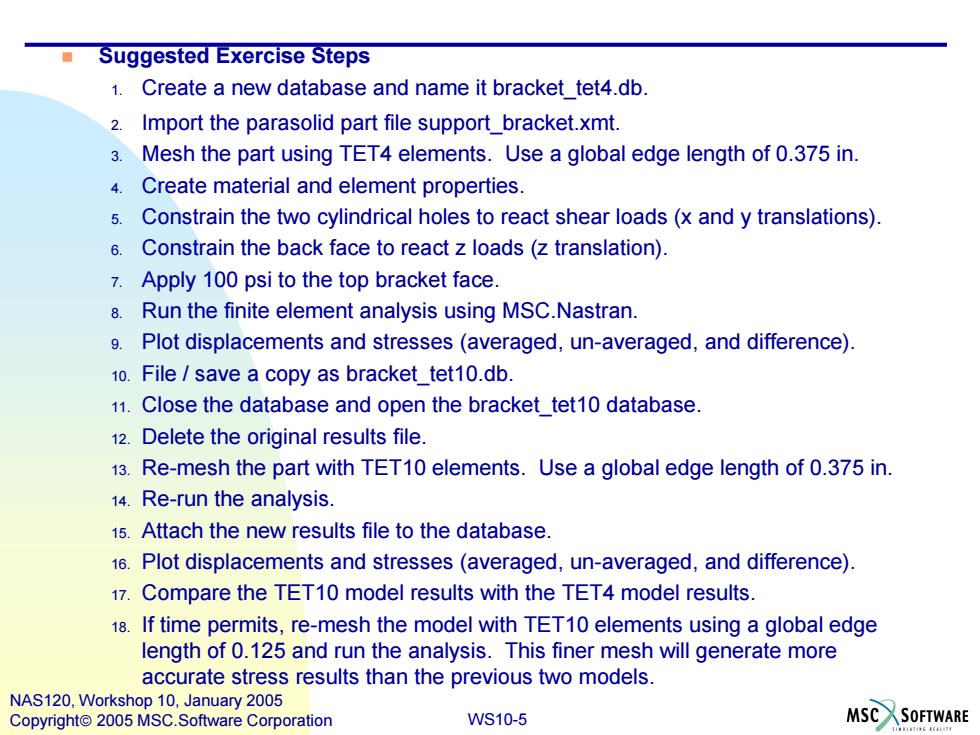
Suggested Exercise Steps 1.Create a new database and name it bracket tet4.db 2.Import the parasolid part file support_bracket.xmt. 3.Mesh the part using TET4 elements.Use a global edge length of 0.375 in. 4.Create material and element properties. 5.Constrain the two cylindrical holes to react shear loads(x and y translations). 6.Constrain the back face to react z loads (z translation). 7.Apply 100 psi to the top bracket face. 8.Run the finite element analysis using MSC.Nastran 9.Plot displacements and stresses (averaged,un-averaged,and difference). 10.File save a copy as bracket_tet10.db. 11.Close the database and open the bracket_tet10 database. 12.Delete the original results file. 13.Re-mesh the part with TET10 elements.Use a global edge length of 0.375 in. 14.Re-run the analysis. 1s.Attach the new results file to the database. 16.Plot displacements and stresses(averaged,un-averaged,and difference). 17.Compare the TET10 model results with the TET4 model results. 18.If time permits,re-mesh the model with TET10 elements using a global edge length of 0.125 and run the analysis.This finer mesh will generate more accurate stress results than the previous two models. NAS120,Workshop 10,January 2005 Copyright 2005 MSC.Software Corporation WS10-5 MSC SOFTWARE
WS10-5 NAS120, Workshop 10, January 2005 Copyright 2005 MSC.Software Corporation Suggested Exercise Steps 1. Create a new database and name it bracket_tet4.db. 2. Import the parasolid part file support_bracket.xmt. 3. Mesh the part using TET4 elements. Use a global edge length of 0.375 in. 4. Create material and element properties. 5. Constrain the two cylindrical holes to react shear loads (x and y translations). 6. Constrain the back face to react z loads (z translation). 7. Apply 100 psi to the top bracket face. 8. Run the finite element analysis using MSC.Nastran. 9. Plot displacements and stresses (averaged, un-averaged, and difference). 10. File / save a copy as bracket_tet10.db. 11. Close the database and open the bracket_tet10 database. 12. Delete the original results file. 13. Re-mesh the part with TET10 elements. Use a global edge length of 0.375 in. 14. Re-run the analysis. 15. Attach the new results file to the database. 16. Plot displacements and stresses (averaged, un-averaged, and difference). 17. Compare the TET10 model results with the TET4 model results. 18. If time permits, re-mesh the model with TET10 elements using a global edge length of 0.125 and run the analysis. This finer mesh will generate more accurate stress results than the previous two models
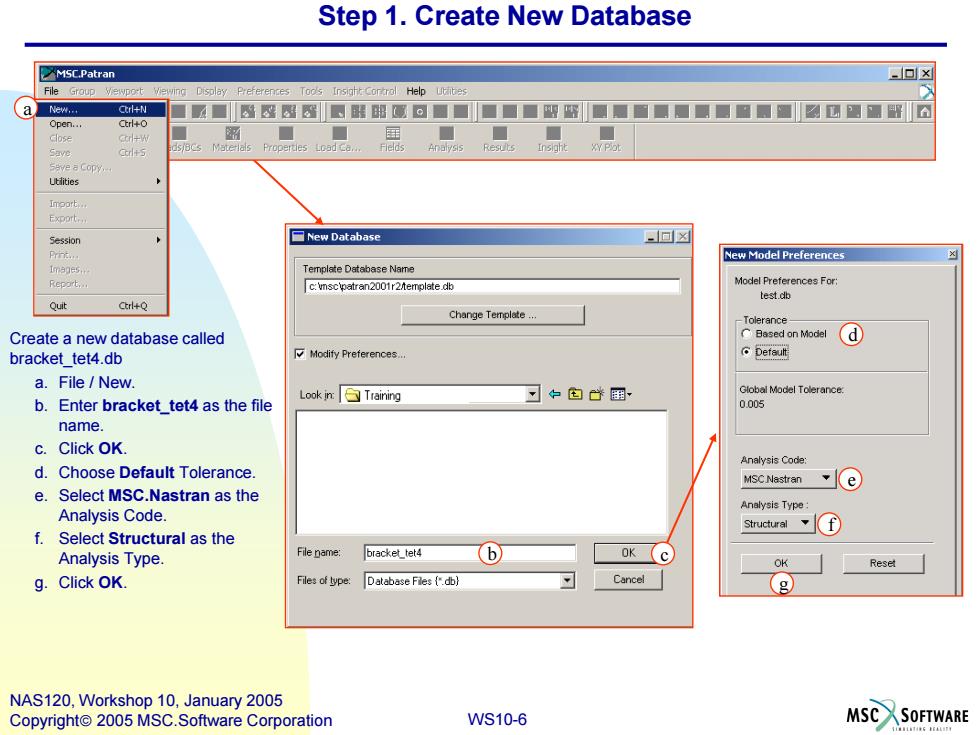
Step 1.Create New Database MSC.Patran 回x File Group ewport viewing Display Preferences Tods Insight Cortrol Help Utlibes New. Ctrl+N 4■图图器■解留厦■■■■■四图■■■■■■■■■■U圆■解 CErl+O ■■ edstacs Mateains Properties toadl 3y0 Cal+s Ssve a Copy Imoort. Session □New Database 回凶 Prnt New Model Preferences tmsges Template Database Name c:vscpatran2001r2/emplate.db Model Preferences For: test db Quit Ctrl+Q Change Templete... -Tolerance Create a new database called CBesed on Model d bracket tet4.db Modify Preferences.. Default a.File New. Look in:Training 中包心国 b.Enter bracket tet4 as the file 0005 name. c.Click OK. Analysis Code d.Choose Default Tolerance. MSC Nastran e e.Select MSC.Nastran as the Analysis Type Analysis Code. Structuralf f.Select Structural as the Analysis Type. File name: bracket_tet4 b OKC OK Reset g.Click OK. Files of type Database Fles (db} Cancel g NAS120,Workshop 10,January 2005 Copyright 2005 MSC.Software Corporation WS10-6 MSC SOFTWARE
WS10-6 NAS120, Workshop 10, January 2005 Copyright 2005 MSC.Software Corporation a b c d f g Step 1. Create New Database Create a new database called bracket_tet4.db a. File / New. b. Enter bracket_tet4 as the file name. c. Click OK. d. Choose Default Tolerance. e. Select MSC.Nastran as the Analysis Code. f. Select Structural as the Analysis Type. g. Click OK. a e